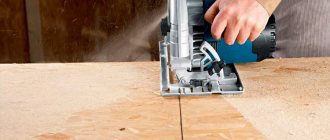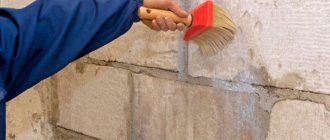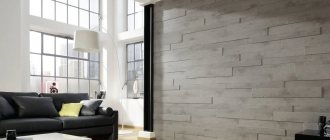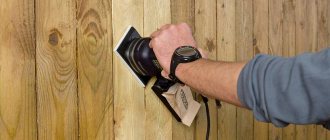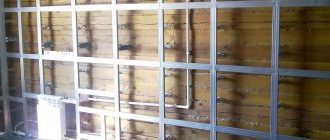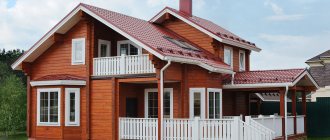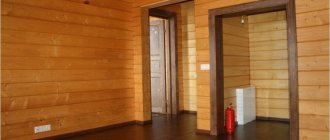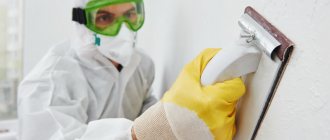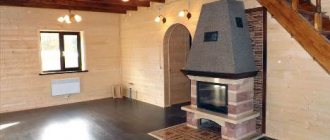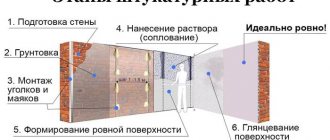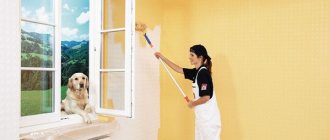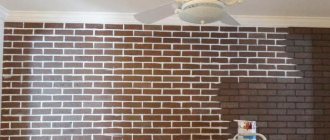In the process of building your home, it is important not only to do everything efficiently and reliably, but also beautifully. You will spend a lot of time in your home and you want a comfortable and cozy atmosphere to promote relaxation and good mood.
Therefore, almost all homeowners pay maximum attention to the interior decoration of the premises. Those who prefer a soft and natural interior and have used wooden material for decoration, for example, imitation timber, should know that such a product requires proper care and processing, for example, painting or varnishing.
Why paint imitation timber inside the house?
Imitation timber needs painting, since this material is very vulnerable to external factors . If you cover a facade with imitation timber, then it needs to provide increased operational and protective properties. As for the interior decoration of rooms, there are no such requirements for products.
Painting is often used if it is necessary to give the surface of the imitation timber a specific color. But despite the fact that the conditions in which the material is used are not as aggressive as in the case of external finishing, it is still recommended to process the product.
If you do not want to purchase a composition with a colored pigment, then you can use transparent paints and varnishes . With their help, the wood material will acquire sufficient protective properties that will prevent it from drying out, cracking and loss of appearance.
It is also important that many compositions intended for treating wood provide good vapor permeability of the entire surface.
IMPORTANT!
Imitation timber is a breathable material, which means that moisture will not accumulate inside the room.
The main stages of painting profiled lumber
The main stages of painting internal and external walls made of profiled timber:
- Wall preparation (sanding and cleaning).
- Antiseptic treatment.
- Coating with protective paint and varnish material (2 layers).
For the convenience of readers, we present video instructions for painting a house made of profiled timber:
Painting the walls will not cause any great difficulties, the only thing is that it is a labor-intensive sanding process. For profiled timber, sanding begins with a P80 nozzle and ends with P220 - 240. The latter nozzles are also used between layers of the main paint to remove excess hairiness.
Internal processing can be carried out at any time of the year. Outdoor - only in dry times at temperatures above +5 degrees. When working outside, you can use a spray gun; inside, it is better to use a brush or roller. The entire structure from the walls to the floor beams must be covered with protective agents.
The cost of painting with your own hands starts from 120 rubles/m2 outside the house and from 170 rubles/m2 inside. Work with the material costs from 450 rubles/m2; for example, painting an 8X9 box on both sides in one layer will cost from 60 thousand rubles.
It’s worth getting down to work with your own hands only if you have enough patience and free time. You can make the task easier and order the walls sanded from professionals and paint them yourself. But do not forget that the internal coating must be smooth and without smudges, since the appearance of the rooms depends on this. If you are not sure that you can do this carefully, it is better to hire specialists.
Types of paints - how to paint boards in the interior
Basically, to paint imitation timber inside a house, paints intended for facade work are used. If we consider such compositions from the point of view of painting the surface inside, we can say the following:
- The oil type of paint is used indoors and has sufficient protective properties . It should be remembered that the drying of a surface covered with an oil-based type of paint coating takes quite a long time. The paint also emits a sharp, unpleasant odor that takes a long time to dissipate. It is better not to use this composition for children's rooms;
- alkyd paint will give the surface not only the desired color, but also provide additional protection for the material;
- The acrylic variety of compositions is more suitable for covering imitation timber on the facade of a house. This is explained by the fact that it is characterized by high protection properties, reliability and practicality. With its help, you can carry out treatment indoors, however, such high requirements for paint and its performance characteristics for interior decoration are not imposed.
As for transparent coatings, there is a wide range of compositions designed for painting imitation timber indoors . The use of varnishes or impregnations intended for facades is recommended for rooms with more aggressive and non-standard conditions, for example, for a bathhouse, sauna, swimming pool.
For interior painting of imitation timber, it is best to pay attention to water-based paints, since such materials have a high level of environmental friendliness, which is ideal for residential premises.
NOTE!
In the process of choosing the most suitable composition for internal painting of timber, you must first of all pay attention to the environmental friendliness of the materials.
What characteristics of painting materials should you pay attention to?
- Possibility to use outdoors.
- Can be used indoors (environmentally safe).
- How it holds high temperatures (relevant for steam rooms).
- Does it provide protection against fire and biological damage?
- What materials does it combine with?
- How many layers should be applied?
- How long does it take to renew the coating?
- What kind of materials is the product designed to process (permissible moisture content of the lumber, is there any damage or is our surface completely healthy...).
- Does it form a film (glossy, matte surface...).
- Does the level of vapor permeability of wood change?
- Is there a coloring effect, can it be tinted?
- How long does it take for the layer to dry, at what temperatures can it be applied.
- What application methods are acceptable?
Colored or clear coating
When approaching the question of choosing a colored or transparent composition for painting imitation timber inside a house, it is better to start from your own desires or the general design of the room.
Regarding the protective and practical properties, the compositions do not differ much from each other. To impart a specific color without preserving the natural texture and pattern of wood, pigmented wood paints are used.
If there is a desire to preserve or show the naturalness of imitation timber, then use transparent compounds.
In addition to a suitable transparent paint coating, a special technology for coloring the wooden material is used to reveal its natural beauty.
If there is a need not to repaint the wooden surface, but only change its tone towards dark or light, then use glazes. This transparent composition is also used to create an antique look of wood.
Considering that you have to choose a material for painting the interior surface of a house, finished with imitation timber, from transparent and opaque compounds, it is worth remembering that the painted surface of the wood does not need subsequent varnish treatment.
Paint is an independent composition that provides all the necessary practical properties and gives the appropriate color to the surface. Varnish acts similarly to pigmented paint, but without imparting color to the surface. Therefore, it is not advisable to use both types of compositions.
Surface preparation
Before proceeding directly to painting work, it is necessary to prepare an imitation of timber for this process. The following recommendations will help you prepare the tree:
- Initially, it is necessary to remove a small layer of material from the surface of the beam . To do this, the surface is sanded and polished;
- Afterwards, it is necessary to ensure maximum cleanliness of the surface . Remove all dust from it using a slightly damp cloth or vacuum cleaner;
- if further treatment of the surface with an opaque composition is planned, then you can walk over the imitation timber with a stiff brush and make small indentations in the wood. They will emphasize its naturalness, in combination, for example, with varnish;
- after such measures, they begin to apply antiseptic preparations and impregnations that protect the wood from rotting processes . This is especially important to do in rooms that are characterized by high levels of humidity, for example, in the kitchen or bathroom;
- in some cases, they resort to priming the surface. Such an event will improve the adhesion properties of the base material with the paint and varnish composition;
- After impregnation with such compositions, wait some time, allowing the surface to dry, and begin the painting work itself.
Indoor paint application technology
The number of layers required for interior painting of wood inside a house is two or three. If staining is carried out in only one layer, then after a year you will have to repeat the entire staining procedure again.
The dyeing process is as follows (photo below):
- the first thing to do after preparing the surface is to dilute the coloring composition in a clean and sufficiently large container;
- this must be done in compliance with all specified proportions in order to obtain the desired color (using tinting) and consistency;
- after that, having chosen a tool for painting (it can be a brush, roller or spray gun), they begin to apply paint to the surface of the imitation timber (you should start from the ceiling);
- It is best if you choose a brush for work, do not dip it entirely into the composition and do not pick up a large amount of the composition at one time . This will lead to unevenness of the layer and drips, which are quite difficult to eliminate afterwards;
- The paint is applied to the surface in as thin a layer as possible . During the process, you should control the uniformity of the surface coverage, carefully paint over everything, even hard-to-reach areas;
- after the first layer has completely dried (the drying time for each composition is individual, indicated on the packaging), you can begin the second stage of painting;
- The second layer is applied in the same way.
Mistakes when painting a house yourself
Many people who decide to paint a wooden house themselves are perplexed as to why the coating turned out unsightly, and after a short time it peeled off and they have to repaint it again. Some blame it all on low-quality dye, but even the best paint cannot produce high-quality and beautiful paint when non-professionals take on the job.
Home builders often make many mistakes:
Due attention is not paid to preparing the house, sanding is carried out incorrectly, the painting process is disrupted, the temperature regime is not maintained during work, wet lumber is painted, materials that are incompatible with each other are selected.
All these errors affect the final result, which causes confusion.
Applying varnish
In addition to the fact that you can apply varnish in the same way as paint, having previously treated the surface with an antiseptic, there is an option to make a more original decor for the timber.
It is especially good if a hard brush was used at the surface preparation stage:
- Initially, varnish is applied to the entire surface of the imitation timber in the usual way;
- in particular, pay attention and paint the recesses in the wood surface, which are made with a brush;
- after this layer has dried, it is necessary to remove a few millimeters of the surface using sandpaper or any other convenient tool;
- after this process, the varnish should remain only in the recesses of the wooden surface;
- after sanding, the surface is again cleaned of dust particles and the varnish is reapplied;
- when the surface dries, it will have a distinct and bright wood texture, additionally drawn with the first layer of varnish.
